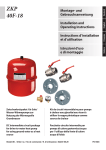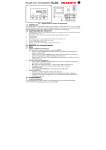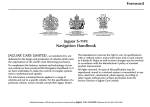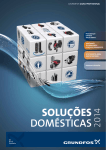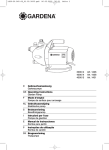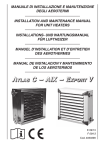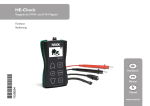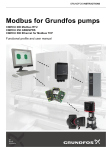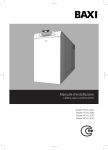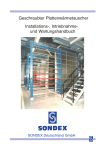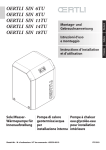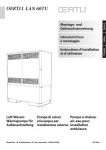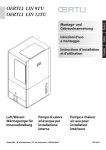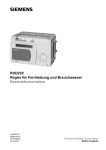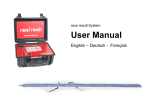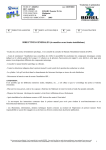Download ZKP 65F-25
Transcript
Instructions d’installation et d’utilisation Français Istruzioni d‘uso e di montaggio Italiano Installation and Operating Instructions Deutsch Montage- und Gebrauchsanweisung English ZKP 65F-25 Zwischenkreispaket für Sole/ Wasser-Wärmepumpe zur Nutzung der Wärmequelle Grundwasser Kit de circuit intermédiaire pour pompe à chaleur eau glycolée/eau visant à utiliser la nappe phréatique comme source de chaleur DC intermediate circuit package for brine-to-water heat pump for using ground water as a heat source Pacchetto circuito intermedio per pompa di calore geotermica/acqua per l‘utilizzo della fonte di calore acqua di falda Bestell-Nr. / Order no. / No de commande / N. d'ordinazione: 452237.66.30 FD 9403 Inhaltsverzeichnis Montage-, Einbau- und Sicherheitshinweise ........................................................................... DE-2 1.1 1.2 1.3 1.4 1.5 1.6 Hydraulische Einbindung: .................................................................................................................... DE-2 Geschraubter Edelstahl-Plattenwärmetauscher .................................................................................. DE-3 Anschluss von Wärmeerzeuger- und Sole-(Zwischen-)kreispumpe:................................................... DE-4 Anschluss Versorgungsspannung ~ 230 V.......................................................................................... DE-6 Anschluss Eingangssignal 0 – 10V................................................................................................... DE-7 Frostschutzthermostat (T) und Durchflussschalter (FS) ...................................................................... DE-7 DE-1 Deutsch 1 1 1 Montage-, Einbau- und Sicherheitshinweise Deutsch Abb. 1.1: Aufbauskizze Bauteilliste: 1) Schmutzfänger 2 ½" Aufbauskizze: 2) Absperrklappe DN 65 2 ½" Bis auf Position 1 sind alle in der Skizze bezifferten Bauteile Bestandteil des Zwischenkreispaketes. Position 1 befindet sich im Lieferumfang der Wärmepumpe. 3) Flanschdichtung 75 (DN 65) 4) Flansch geklebt 5) Überdruckventil DN 25 6) Manometer 7) Kappenventil DN 20 ¾" 8) Ausdehnungsgefäß 25 Liter Bei der gezeigten Skizze handelt es sich um einen Einbindungsvorschlag, von dem aufgrund örtlicher Gegebenheiten abgewichen werden kann. HINWEIS Der Aufbau des Zwischenkreispaketes kann sowohl im als auch außerhalb des Gebäudes erfolgen. Bei Montage im Gebäude muss diffusionsdicht gedämmt werden. Die Umwälzpumpe sollte, wie in der Skizze dargestellt, mit den Absperrventilen als eine Baugruppe montiert werden. HINWEIS Aufgrund konstruktiver Gegebenheiten müssen alle Hocheffizienzpumpen (insbesondere Sole-Umwälzpumpen) an einem trockenen und frostfreien Ort montiert werden! 1.1 Hydraulische Einbindung: Abb. 1.2: Hydraulische Einbindung DE-2 1.2 Geschraubter EdelstahlPlattenwärmetauscher Forderungen an den Aufstellungsbereich: Installation der Rohranschlüsse: ACHTUNG! Beim Anschluss des Rohrsystems an den Wärmetauscher ist darauf zu achten, dass er keinen Belastungen oder Beanspruchungen durch das Rohrsystem ausgesetzt ist! Rohrleitung vor dem Anbau an den Wärmetauscher gründlich reinigen! Schwere Rohrleitungen müssen gestützt werden, um eine Einwirken von starken Kräften auf den Wärmetauscher zu verhindern. Flexible Verbindungen verwenden, um Schwingungseinwirkungen auf den Wärmetauscher zu verhindern und die Ausdehnung der Rohrleitung durch Temperaturschwankungen auf den Wärmetauscher zu kompensieren (spannungsfreier längsgerichteter Einbau). HINWEIS Um eine ausreichende Entlüftung zu gewährleisten, sollten die Entlüftungsventile an der höchsten Stelle in Fließrichtung des Mediums (vorzugsweise auf einem Druckbehälter) angebracht werden. Es können Absperrventile an allen Anschlüssen des Wärmetauschers vorgesehen werden, um das Öffnen bei Bedarf zu erleichtern! Gewinderohranschlüsse: Um den Plattenwärmetauscher ist ausreichend Platz für die Instandhaltung (Austausch von Platten, Festziehen des Paketes) frei zu halten. In der Regel sollte der Freiraum 1,5 bis 2 x die Breite des Wärmetauschers betragen. Bei der Montage darauf achten, dass diese Anschlüsse beim Anbau von Rohrverbindungsstücken oder Flanschen sich nicht mit drehen. Transport, Heben des Plattenwärmetauschers: Ein Drehen der Gewinderohranschlüsse könnte die Dichtung im Wärmetauscher, die als Abdichtung gegen die Rückseite des Rohranschlusses vorgesehen ist, beschädigen! Der Wärmetauscher wird fest verschraubt auf einer Palette angeliefert. Beim Anheben des Gerätes sind folgende Punkte zu beachten: Flanschanschlüsse: Befestigungsschrauben von der Palette entfernen. Gurte um einen Bolzen auf jeder Seite anbringen. Niemals Stahlseile oder Ketten verwenden! Den Wärmetauscher von der Palette heben, dabei langsam horizontal auf seine Füße absenken und in seiner Endstellung auf festem Boden platzieren, ggf. befestigen! ACHTUNG! Den Wärmetauscher niemals an den Anschlüssen oder den darum befindlichen Stehbolzen anheben! Immer die Hebeösen (falls vorhanden) verwenden, bzw. an der Oberseite der vorderen Platte anheben. Dazu die Gurte an deren Bolzen befestigen. Wenn der Anschluss mit Gummi ausgekleidet ist, wirkt die Auskleidung gleichzeitig als Flanschdichtung. Der Anschlussflansch ist unter Verwendung der vorgesehenen Gewindebohrungen direkt an der Endplatte anzuschließen. Die Schrauben sind gleichmäßig festzuziehen – nicht übermäßig anziehen, da dies die in die Rahmenplatte eingeschnittenen Gewinde überdrehen könnte. Wenn lose Stützflansche am Wärmetauscher angebaut sind, ist eine geeignete Dichtung zur Abdichtung des Flansches erforderlich. Inbetriebnahme: ACHTUNG! Zuerst den kalten Kreislauf, dann den heißen Kreislauf starten. Anlage vollkommen entlüften, dazu die Absperrventile zwischen Pumpe und Wärmetauscher schließen (falls ein Ventil in den Rücklauf des Wärmetauschers installiert wurde, dieses öffnen). Anschließend die Sole-Umwälzpumpe starten und die Ventile im Vorlauf zum Wärmetauscher stufenweise öffnen. Falls notwendig, nochmals entlüften und obige Schritte für den Sekundärkreislauf wiederholen, wenn es sich ebenfalls um einen geschlossenen Kreislauf handelt. DE-3 Deutsch 1.2 1.3 1.3 Anschluss von Wärmeerzeuger- und Sole-(Zwischen-)kreispumpe: Heizkreis(e) Deutsch Warmwasserbereitung Abb. 1.3: Anschluss von Wärmeerzeuger- und Sole-(Zwischen-)kreispumpe Wärmeerzeugerkreispumpe M 16: Zwischenkreispumpe M11: Brunnenpumpe M11: SI 50TU WSI 65TU SI 75TU WSI 90TU SI 90TU WSI 110TU Magna Geo 32100VDC Magna3 40-80F Magna3 65-80F Magna3 65-80F Magna3 65-100F Magna3 65-100F Bauseits bereitzustellen HINWEIS Die mitgelieferten Dämmschalen dürfen auf der Wärmequellenseite (Verwendung als Sole-Umwälzpumpe M11) NICHT eingesetzt werden! HINWEIS Aufgrund konstruktiver Gegebenheiten müssen alle Hocheffizienzpumpen (insbesondere Sole-Umwälzpumpen) an einem trockenen und frostfreien Ort montiert werden! DE-4 1.3 Technische Daten Magna Geo 32-100VDC Technische Daten Magna3 65-80F Einsatztemperaturbereich -10 °C bis 110 °C Einsatztemperaturbereich Einbaulänge 180 mm Einbaulänge 340 mm Leistungsaufnahme max. (P1) 175 W Leistungsaufnahme max. (P1) 478 W Stromaufnahme max. (I1) 1,3 A Stromaufnahme max. (I1) 2,12A Pumpenkennlinie: Fördermedium = Wasser Medientemperatur = 60 °C Dichte = 983.2 kg/m³ Technische Daten Magna3 40-80F Einsatztemperaturbereich -10 °C bis 110 °C Einbaulänge 220 mm Leistungsaufnahme max. (P1) 265 W Stromaufnahme max. (I1) 1,2 A Pumpenkennlinie: Fördermedium = Wasser Medientemperatur = 60 °C Dichte = 983.2 kg/m³ DE-5 Deutsch Pumpenkennlinie: -10 °C bis 110 °C 1.4 1.4 Technische Daten Magna3 65-100F Einsatztemperaturbereich -10 °C bis 110 °C Einbaulänge 340 mm Leistungsaufnahme max. (P1) 613 W Stromaufnahme max. (I1) 2,7 A Anschluss Versorgungsspannung ~ 230 V Magna Geo 32-100VDC Deutsch Pumpenkennlinie: Fördermedium = Wasser Medientemperatur = 60 °C Dichte = 983.2 kg/m³ $XIOHJHQGHU9HUVRUJXQJVVSDQQXQJ $OSKD6WHFNHUa913(±LP/LHIHUXPIDQJ .DEHOEDXVHLWV Magna3 40-80F bis Magna3 65-100F Anschluss direkt an der Pumpenklemmleiste – Deckel vom Pumpenhopf abschrauben – Einführung des Anschlusskabel (bauseits) durch PG-Verschraubungen Wärmepumpe: Klemmleiste X2 Koppelrelais M11 / M16 vorverdrahtet DE-6 1.6 Anschluss Eingangssignal 0 – 10V Magna Geo 32-100VDC 1.6 Frostschutzthermostat (T) und Durchflussschalter (FS) Rohranlegethermostat RAT 060I (Frostschutz): ACHTUNG! Um eine einwandfreie Funktion des/der Geräte(s) zu gewährleisten, sind die folgend beschriebenen Hinweise zu beachten. Am Montageort dürfen keine Temperaturschichtungen in der Rohrleitung auftreten. Die Rohroberfläche muss am Montageort blank sein, ggf. Farbe oder sonstige Isolation entfernen. Kupplungs-Stecker (w) mit Kabel 2,25 m Pumpenstecker (m) blaue Ader: 0 – 10V GND braune Ader: 0 – 10V Eingang schwarze Ader: 0 –10 V Ausgang (nicht notwendig!!) Das beigefügte Spannband wird durch den Fühlersockel gesteckt und an der Rohrleitung festgezogen. Überlänge kann abgeschnitten werden. Der Anlegefühler muss fest am Rohr anliegen (ggf. Wärmeleitpaste verwenden)! Befestigungsclip für Steckverbinder Magna3 40-80F bis Magna3 65-100F Anschluss direkt an der Pumpenklemmleiste – Deckel vom Pumpenhopf abschrauben – Einführung des Anschlusskabel (bauseits) durch PG-Verschraubungen Spannbandverriegelung kann mit einem Schraubendreher zur Demontage gelöst werden. Pumpe Klemme Signal M 16 J4/Y3 - X3 GND 0 - 10 V Schaltfunktion: M 11 Zwischenkreispumpe J4/Y4 - X3 GND 0 - 10 V M 11 Brunnenpumpe optional Erreicht oder unterschreitet die Temperatur den eingestellten Sollwert von 4 °C, schaltet der Wechsler von Klemme P1 - 2 nach P1 - 1. Steigt die Temperatur um ca. 4 K über den Sollwert, schaltet der Wechsler wieder zurück Anschluss Anschluss Frostschutzthermostat (T) am Wärmepumpenmanager: N1 ID 3 und X3 G / 24 V AC als Kontakt im Ruhezustand (kein Durchfluss) ACHTUNG! Ein zusätzlich installierter Durchflussschalter DFS im Primärkreis (FS) verhindert ein Einschalten der Wärmepumpe bei fehlendem Volumenstrom der Kühl- bzw. Grundwasserpumpe. Anschluss Durchflussschalter (FS) am Wärmepumpenmanager: N1 ID 8/10/xx und X3 G DE-7 Deutsch 1.5 1.6 Deutsch DE-8 Table of contents Assembly, installation and safety instructions .......................................................................GB-2 1.1 1.2 1.3 1.4 1.5 1.6 Hydraulic integration: ........................................................................................................................... GB-3 Screwed stainless steel plate heat exchanger..................................................................................... GB-3 Connecting the heat generator and brine (intermediate) circuit pump:................................................ GB-4 Connection supply voltage ~ 230 V ..................................................................................................... GB-6 Connection input signal 0 – 10V .......................................................................................................... GB-7 Frost protection thermostat (T) and flow rate switch (FS).................................................................... GB-7 English 1 GB-1 1 1 Assembly, installation and safety instructions English Fig. 1.1: Layout Layout: Apart from position 1, all components numbered in the drawing form part of the DC intermediate circuit. Position 1 is included in the heat pump scope of supply. The drawing shown is a suggested integration, which may be deviated from in practice due to conditions on-site. Components list: 1) Dirt trap 2 ½" 2) Isolating valve DN 65 2 ½" 3) Flange seal 75 (DN 65) 4) Flange, glued 5) Pressure relief valve DN 25 6) Pressure gauge 7) Cap valve DN 20 ¾" 8) Expansion vessel 25 litres NOTE The equipment for the DC intermediate circuit can be mounted inside or outside the building. Diffusion-tight insulation is required for installation in buildings. The circulating pump should be mounted as an assembly with the isolating valves as shown in the drawing. NOTE For design reasons, all high-efficiency pumps (in particular brine circulating pumps) must be mounted in a dry and frost-free place! GB-2 1.2 Hydraulic integration: Fig. 1.2: Hydraulic integration 1.2 Screwed stainless steel plate heat exchanger English 1.1 Requirements on the installation area: Transport, lifting the plate heat exchanger: The heat exchanger is delivered screwed to a plate. The following points must be observed when lifting the device: Remove the fixing screws from the pallet. Attach a strap around a bolt on each side. Never use steel cables or chains! Lift the heat exchanger from the pallet, lower it horizontally onto its feet and position in its end position on solid ground, fix in place if necessary! ATTENTION! Never lift the heat exchanger by the connections or surrounding stud bolts! Always use the lifting lugs (if present) or lift on the top side of the front pallet. Fix the straps onto their bolts for this. Sufficient space must be left free around the plate heat exchanger for maintenance (replacing plates, tightening the package). The free space should usually be around 1.5 to 2 x the width of the heat exchanger. GB-3 1.3 Installation of the pipe connections: Flange connections: When connecting the pipe system to the heat exchanger, ensure that it is not subjected to stress or strain by the pipe system! Clean the pipework before installation on the heat exchanger! If the connection is lined with rubber, the lining also acts as a flange seal. The connection flange should be connected directly to the end plate using the designated tapped holes. The screws should be tightened evenly - do not tighten excessively, as this could overwind the threads cut in to the frame plate. Heavy pipework must be supported to prevent strong forces from being applied on the heat exchanger. If loose support flanges are mounted on the heat exchanger, a suitable seal is required for sealing the flange. Use flexible connections to prevent vibrations on the heat exchanger and to compensate for the expansion of the pipes caused by temperature fluctuations on the heat exchanger (tension-free lengthways installation). Commissioning: ATTENTION! English NOTE To guarantee adequate venting, the bleeder valves should be mounted in the highest position in the flow direction of the medium (preferably on a pressure vessel). Isolating valves can be used on all connections of the heat exchanger to make them easier to open when necessary! Threaded pipe connections: During installation, ensure that these connections do not turn while pipe connectors or flanges are being mounted. ATTENTION! Start the cold circuit first, followed by the hot circuit. Purge the system completely by closing the isolating valves between the pump and the heat exchanger (if a valve is installed in the return of the heat exchanger, open it). Then start the brine circulating pump and open the valves in the flow to the heat exchanger gradually. If necessary, purge again and repeat the above steps for the secondary circuit if this is also a closed circuit. Turning the threaded pipe connections could damage the seal in the heat exchanger, which acts as a seal against the rear side of the pipe connection! 1.3 Connecting the heat generator and brine (intermediate) circuit pump: Heating circuit(s) Domestic hot water preparation Fig. 1.3: Connecting the heat generator and brine (intermediate) circuit pump Heat generator circuit pump M 16: Intermediate circuit pump M11: Well pump M11: GB-4 SI 50TU WSI 65TU SI 75TU WSI 90TU SI 90TU WSI 110TU Magna Geo 32100VDC Magna3 40-80F Magna3 65-80F Magna3 65-80F Magna3 65-100F Magna3 65-100F To be provided on-site 1.3 NOTE The insulation shells provided may NOT be used on the heat source side (use as brine circulating pump M11)! NOTE English For design reasons, all high-efficiency pumps (in particular brine circulating pumps) must be mounted in a dry and frost-free place! Technical data Magna Geo 32-100VDC Operating temperature range -10 °C to 110 °C Installation length 180 mm Power consumption max. (P1) 175 W Current consumption max. (I1) 1.3 A Technical data Magna3 65-80F Pump characteristic curve: Operating temperature range -10 °C to 110 °C Installation length 340 mm Power consumption max. (P1) 478 W Current consumption max. (I1) 2.12A Pump characteristic curve: 3XPSHGPHGLXP ZDWHU 0HGLDWHPSHUDWXUH & 'HQVLW\ NJPñ Technical data Magna3 40-80F Operating temperature range -10 °C to 110 °C Installation length 220 mm Power consumption max. (P1) 265 W Current consumption max. (I1) 1.2 A Pump characteristic curve: 3XPSHGPHGLXP ZDWHU 0HGLDWHPSHUDWXUH & 'HQVLW\ NJPñ GB-5 1.4 1.4 Technical data Magna3 65-100F Operating temperature range -10 °C to 110 °C Installation length 340 mm Power consumption max. (P1) 613 W Current consumption max. (I1) 2.7 A Connection supply voltage ~ 230 V Magna Geo 32-100VDC English Pump characteristic curve: 3XPSHGPHGLXP ZDWHU 0HGLDWHPSHUDWXUH & 'HQVLW\ NJPñ $SSO\LQJWKHVXSSO\YROWDJH $OSKDSOXJa913(±LQVFRSHRIVXSSO\ FDEOHVRQVLWH Magna3 40-80F to Magna3 65-100F &RQQHFWLRQGLUHFWO\RQWKHSXPSWHUPLQDOVWULS± XQVFUHZWKHFRYHUIURPWKHSXPSKHDG± LQVHUWWKHFRQQHFWLRQFDEOHRQVLWHWKURXJK3*JODQGV +HDWSXPSWHUPLQDOVWULS; &RXSOLQJUHOD\00SUHZLUHG GB-6 1.6 1.5 Connection input signal 0 – 10V Magna Geo 32-100VDC 1.6 Frost protection thermostat (T) and flow rate switch (FS) ATTENTION! In order to ensure fault-free functioning of the device(s), the instructions given in the following text must be observed. &RXSOLQJSOXJZZLWKPFDEOH 3XPSSOXJP EOXHZLUH±9*1' EURZQZLUH±9LQSXW EODFNZLUH±9RXWSXWQRWUHTXLUHG )L[LQJFOLSIRUSOXJFRQQHFWRU No temperature stratification must occur in the pipework at the installation site. The surface of the pipe must be bare at the installation site and any paint or other insulation must be removed. The tightening strap provided is inserted through the sensor base and pulled tight on the pipework. Excess lengths can be cut off. The strap-on sensor must lie tightly against the pipe (use heat transfer compound if necessary)! Magna3 40-80F to Magna3 65-100F &RQQHFWLRQGLUHFWO\RQWKHSXPSWHUPLQDOVWULS± XQVFUHZWKHFRYHUIURPWKHSXPSKHDG± LQVHUWWKHFRQQHFWLRQFDEOHRQVLWHWKURXJK3*JODQGV Pump Terminal Signal M 16 J4/Y3 - X3 GND 0 - 10 V M 11 intermediate circuit pump J4/Y4 - X3 GND 0 - 10 V M 11 well pump Optional 7KHWLJKWHQLQJVWUDSORFN FDQEHUHOHDVHGZLWKD VFUHZGULYHUIRU GLVPDQWOLQJ Switching function: If the temperature reaches or falls short of the set setpoint of 4 °C, the changeover contact switches from terminal P1 - 2 to P1 - 1. If the temperature exceeds the setpoint by approx. 4 K, the changeover contact switches back again &RQQHFWLRQ GB-7 English Pipe-mounted thermostat RAT 060I (frost protection): 1.6 Connecting the frost protection thermostat (T) to the heat pump manager: N1 ID 3 and X3 G / 24 V AC as Contact in inactive state (no flow rate) English ATTENTION! An additional flow rate switch installed in the primary circuit (FS) prevents the heat pump from switching on if the volume flow of the cooling water or ground water pump is not present. Connecting the flow rate switch (FS) to the heat pump manager: N1 ID 8/10/xx and X3 G GB-8 Table des matières Consignes de montage et de sécurité...................................................................................... FR-2 1.1 1.2 1.3 1.4 1.5 1.6 Intégration hydraulique : .......................................................................................................................FR-3 Echangeur thermique à plaques en acier inoxydable vissé..................................................................FR-3 Raccordement de la pompe du circuit (intermédiaire) du générateur de chaleur et d'eau glycolée : ...FR-4 Raccordement de la tension d'approvisionnement ~ 230 V .................................................................FR-7 Raccordement du signal d'entrée 0 – 10 V........................................................................................FR-7 Thermostat de protection antigel (T) et commutateur de débit (FS).....................................................FR-8 Français 1 FR-1 1 1 Consignes de montage et de sécurité Français Fig. 1.1: Schéma de structure Liste des composants : 1) Collecteur d'impuretés 2 ½" Schéma de structure : 2) Clapet d'arrêt DN 65 2 ½" À l'exception de la position 1, tous les composants numérotés dans le schéma font partie intégrante du kit du circuit intermédiaire. La position 1 fait partie des fournitures de la pompe à chaleur. 3) Joint de bride 75 (DN 65) 4) Bride collée 5) Soupape de surpression DN 25 Le schéma illustré constitue une suggestion d'intégration ; des conditions locales peuvent être à l'origine de divergences. 6) Manomètre 7) Soupape à capot DN 20 ¾" 8) Vase d'expansion 25 litres REMARQUE Le montage du kit du circuit intermédiaire peut se faire tant à l’intérieur qu’à l’extérieur du bâtiment. Lors du montage à l'intérieur du bâtiment, l'isolation contre la diffusion doit être garantie. Le circulateur doit être monté comme sur le schéma, les vannes d'arrêt formant un module. REMARQUE En raison de conditions de construction, toutes les pompes haute performance (en particulier les circulateurs d'eau glycolée) doivent être montées à un emplacement sec et à l'abri du gel ! FR-2 1.2 Intégration hydraulique : Français 1.1 Fig. 1.2: Intégration hydraulique 1.2 Echangeur thermique à plaques en acier inoxydable vissé Exigences relatives à la zone d'installation : Transport, levage de l'échangeur thermique à plaques : L'échangeur thermique est livré vissé sur une palette. Lors du levage de l'appareil, respecter les points suivants : Retirer les vis de fixation de la palette. Appliquer de chaque côté des sangles autour d'un goujon. Ne jamais utiliser de câbles d'acier ou de chaînes ! Lever l'échangeur thermique de la palette, puis le descendre lentement horizontalement sur ses pieds et le placer à sa position finale sur un sol ferme, le fixer le cas échéant ! ATTENTION ! Ne jamais soulever l'échangeur thermique au niveau des raccordements ou du goujon tirant situé autour ! Toujours utiliser les anneaux de levage (si existants) ou soulever au niveau de la face supérieure de la plaque avant. De plus, fixer les sangles aux goujons. Conserver suffisamment d'espace libre autour de l'échangeur thermique à plaques pour la maintenance (remplacement de plaques, serrage du kit). En règle générale, l'espace libre doit correspondre à 1,5-2 x la largeur de l'échangeur thermique. FR-3 1.3 Installation des raccordements de tuyaux : Raccordements par bride : ATTENTION ! Français Lors du raccordement du système de tuyauteries à l'échangeur thermique, il faut veiller à ce que ce dernier ne soit exposé à aucune charge, ni aucune sollicitation de la part du système de tuyauteries ! Nettoyer soigneusement les tuyauteries avant le montage sur l'échangeur thermique ! Les tuyauteries lourdes doivent être étayées pour empêcher l'action de forces puissantes sur l'échangeur thermique. Utiliser des raccordements souples pour empêcher les effets oscillatoires sur l'échangeur thermique et compenser la dilatation des tuyauteries sous l'effet de variations de température sur l'échangeur (montage longitudinal sans tension). REMARQUE Pour garantir une purge suffisante, les vannes de purge doivent être installées au point le plus haut dans la direction d'écoulement du fluide (de préférence sur un réservoir sous pression). Des vannes d'arrêt peuvent être prévues sur tous les raccordements de l'échangeur thermique pour faciliter l'ouverture en cas de besoin ! Si le raccordement est revêtu de caoutchouc, le revêtement agit simultanément comme joint de bride. La bride de raccordement doit être raccordée directement à la plaque d'extrémité en utilisant les trous filetés prévus. Serrer les vis uniformément, sans excès, sous peine de détériorer les filetages découpés dans la plaque de cadre. Si des flasques lâches sont montés sur l'échangeur thermique, un joint approprié est nécessaire pour assurer l'étanchéité de la bride. Mise en service : ATTENTION ! Démarrer d'abord le circuit froid, puis le circuit chaud. Purger complètement l'installation ; pour ce faire, fermer les vannes d'arrêt situées entre la pompe et l'échangeur thermique (si une vanne a été installée dans le retour de l'échangeur thermique, l'ouvrir). Raccordements de tubes filetés : Démarrer ensuite le circulateur d'eau glycolée et ouvrir progressivement les vannes situées dans le départ en direction de l'échangeur thermique. Lors du montage, veiller à ce que ces raccordements ne tournent pas pendant la pose d'accessoires de tuyauteries ou de brides. Si nécessaire, purger à nouveau et répéter les étapes ci-dessus pour le circuit secondaire s'il s'agit également d'un circuit fermé. Une rotation des raccordements de tubes filetés pourrait endommager le joint de l'échangeur thermique, qui assure l'étanchéité contre la face arrière du raccordement de tuyau ! 1.3 Raccordement de la pompe du circuit (intermédiaire) du générateur de chaleur et d'eau glycolée : Circuit(s) de chauffage Production d’eau chaude sanitaire Fig. 1.3: Raccordement de la pompe du circuit (intermédiaire) du générateur de chaleur et d'eau glycolée FR-4 1.3 SI 75TU WSI 90TU SI 90TU WSI 110TU Magna Geo 32100 V CC Magna3 40-80F Magna3 65-80F Magna3 65-80F Magna3 65-100F Magna3 65-100F Mise à disposition sur site Français Pompe du circuit du générateur de chaleur M 16 : Pompe de circuit intermédiaire M11 : Pompe d’eau de puits M11 : SI 50TU WSI 65TU Caractéristiques techniques Magna3 40-80F REMARQUE Les enveloppes isolantes fournies ne doivent PAS être utilisées sur le côté source de chaleur (utilisation en tant que circulateur d'eau glycolée M11) ! REMARQUE En raison de conditions de construction, toutes les pompes haute performance (en particulier les circulateurs d'eau glycolée) doivent être montées à un emplacement sec et à l'abri du gel ! Plage de températures d'utilisation de -10 °C ·110 °C Longueur de montage 220 mm Puissance absorbée max. (P1) 265 W Consommation de courant max. (I1) 1,2 A Courbe caractéristique de la pompe : )OXLGHG DOLPHQWDWLRQ HDX 7HPSpUDWXUHGHVIOXLGHV & 'HQVLWp NJPñ Caractéristiques techniques Magna Geo 32-100 V CC Plage de températures d'utilisation de -10 °C ·110 °C Longueur de montage 180 mm Puissance absorbée max. (P1) 175 W Consommation de courant max. (I1) 1,3 A Courbe caractéristique de la pompe : FR-5 1.3 Caractéristiques techniques Magna3 65-80F Caractéristiques techniques Magna3 65-100F Plage de températures d'utilisation de -10 °C ·110 °C Plage de températures d'utilisation de -10 ? ·110 ? Longueur de montage 340 mm Longueur de montage 340 mm Puissance absorbée max. (P1) 478 W Puissance absorbée max. (P1) 613 W Consommation de courant max. (I1) 2,12A Consommation de courant max. (I1) 2,7 A Français Courbe caractéristique de la pompe : Courbe caractéristique de la pompe : )OXLGHG DOLPHQWDWLRQ HDX 7HPSpUDWXUHGHVIOXLGHV & 'HQVLWp NJPñ )OXLGHG DOLPHQWDWLRQ HDX 7HPSpUDWXUHGHVIOXLGHV & 'HQVLWp NJPñ FR-6 1.5 1.4 Raccordement de la tension d'approvisionnement ~ 230 V Raccordement du signal d'entrée 0 – 10 V Magna Geo 32-100 V CC Français Magna Geo 32-100 V CC 1.5 &RQQHFWHXUGHFRXSODJHZDYHFFkEOHP &RQQHFWHXUGHSRPSHP )LOEOHX±9*1' )LOPDUURQ±9HQWUpH )LOQRLU±9VRUWLHQRQQpFHVVDLUH $SSOLFDWLRQGHODWHQVLRQG DSSURYLVLRQQHPHQW &RQQHFWHXU$OSKDa913(±GDQVOHV IRXUQLWXUHV FkEOHjIRXUQLUSDUOHFOLHQW &OLSGHIL[DWLRQGXFRQQHFWHXU Magna3 40-80F à Magna3 65-100F Magna3 40-80F à Magna3 65-100F 5DFFRUGHPHQWGLUHFWDXERUQLHUGHODSRPSH± 'pYLVVDJHGXFRXYHUFOHGHODWrWHGHSRPSH± ,QVHUWLRQGXFkEOHGHEUDQFKHPHQWVXUVLWH YLDGHVSUHVVHpWRXSHV3* 5DFFRUGHPHQWGLUHFWDXERUQLHUGHODSRPSH± 'pYLVVDJHGXFRXYHUFOHGHODWrWHGHSRPSH± ,QVHUWLRQGXFkEOHGHEUDQFKHPHQWVXUVLWHYLDGHVSUHVVHpWRXSHV3* Pompe Borne M 16 J4/Y3 - X3 GND Signal 0 - 10 V Pompe de circuit intermédiaire M 11 J4/Y4 - X3 GND 0 - 10 V Pompe d'eau de puits M 11 en option 3RPSHjFKDOHXUERUQLHU; 5HODLVGHFRXSODJH 00SUpFkEOp FR-7 1.6 1.6 Thermostat de protection antigel (T) et commutateur de débit (FS) Raccordement du thermostat de protection antigel (T) au gestionnaire de pompe à chaleur : N1 ID 3 et X3 G / 24 V CA en tant que Contact au repos (pas de débit) Français Thermostat à tube RAT 060I (protection antigel) : ATTENTION ! Pour garantir un fonctionnement irréprochable du (des) appareil(s), tenir compte des remarques suivantes. Sur le lieu de montage, aucune stratification de température ne doit se produire dans les tuyauteries. La surface du tuyau doit être à nu à l'emplacement de montage, le cas échéant, retirer la couleur ou une éventuelle isolation. La bride d'ajustage jointe est insérée via le socle de la sonde et serrée sur la tuyauterie. La longueur excédentaire peut être coupée. La sonde d'applique doit adhérer fermement au tuyau (le cas échéant, utiliser une pâte thermoconductrice) ! /HYHUURXLOODJHGHOD EULGHG DMXVWDJHSHXW rWUHGpEORTXpSRXUOH GpPRQWDJHjO DLGHG XQ WRXUQHYLV Fonction de commutation : Si la température atteint la valeur consigne ou est inférieure à cette valeur réglée à 4 °C, le contact inverseur commute de la borne P1 - 2 vers P1 - 1. Si la température augmente d'environ 4 K au-dessus de la valeur consigne, le contact inverseur commute de nouveau. 5DFFRUGHPHQW FR-8 ATTENTION ! Un commutateur de débit DFS installé en plus dans le circuit primaire (FS) empêche une mise en marche de la pompe à chaleur en cas d'absence de flux volumique de la pompe de rafraîchissement ou sur nappe phréatique. Raccordement du commutateur de débit (FS) au gestionnaire de pompe à chaleur : N1 ID 8/10/xx et X3 G Indice Indicazioni per il montaggio, l'installazione e la sicurezza ......................................................IT-2 1.1 1.2 1.3 1.4 1.5 1.6 Allacciamento idraulico: ......................................................................................................................... IT-3 Scambiatore di calore a piastre in acciaio inox avvitato ........................................................................ IT-3 Collegamento della pompa (circuito intermedio) del generatore di calore e dell'acqua glicolata: ......... IT-4 Collegamento tensione di alimentazione ~ 230 V.................................................................................. IT-6 Collegamento segnale di ingresso 0 – 10 V ....................................................................................... IT-7 Termostato protezione antigelo (T) e interruttore di portata (FS) .......................................................... IT-7 Italiano 1 IT-1 1 Indicazioni per il montaggio, l'installazione e la sicurezza Italiano Fig. 1.1: Schema di montaggio Lista componenti: 1) Filtro 2 ½" Schema di montaggio: 2) Valvola a farfalla DN 65 2 ½" Fino alla posizione 1 tutti i componenti numerati nel disegno sono parte integrante del pacchetto del circuito intermedio. La posizione 1 si trova nella dotazione di fornitura della pompa di calore. 3) Guarnizione a flangia 75 (DN 65) 4) Flangia attaccata 5) Valvola di sovrapressione DN 25 Il disegno mostrato rappresenta soltanto una proposta di integrazione, dalla quale ci si può discostare in base alle esigenze locali. 6) Manometro 7) Valvola con tappo DN 20 ¾" 8) Vaso d'espansione 25 litri NOTA Il montaggio del pacchetto del circuito intermedio può avvenire sia all'interno che all'esterno dell'edificio. In caso di montaggio all'interno è necessario un isolamento a tenuta di diffusione. La pompa di circolazione deve essere montata come un gruppo costruttivo come nello schema usando le valvole di intercettazione. NOTA A causa del tipo di costruzione, tutte le pompe ad elevata efficienza (in particolare le pompe di circolazione acqua glicolata) devono essere montate in un luogo asciutto e privo di gelo. IT-2 Allacciamento idraulico: Fig. 1.2: Allacciamento idraulico 1.2 Scambiatore di calore a piastre in acciaio inox avvitato Italiano 1.1 Requisiti per il luogo di installazione: ATTENZIONE! Non sollevare mai lo scambiatore tenendolo per i raccordi o per i bulloni passanti. Se presenti, utilizzare sempre i golfari di sollevamento, oppure sollevare dal lato superiore della piastra anteriore. Per fare ciò, fissare le cinghie ai relativi bulloni. Installazione dei raccordi dei tubi: ATTENZIONE! Quando si collega il sistema di tubi allo scambiatore, assicurarsi che quest'ultimo non sia sottoposto a carichi o sollecitazioni dovute al sistema di tubi. Pulire le tubazioni prima del montaggio sullo scambiatore. Le tubazioni pesanti devono essere dotate di un supporto per evitare che forze eccessive influiscano sullo scambiatore. intorno allo scambiatore di calore a piastre è necessario lasciare spazio a sufficienza per le operazioni di manutenzione (sostituzione delle piastre, serraggio del pacchetto). In genere questo spazio deve essere pari a 1,5 - 2 volte la larghezza dello scambiatore. Trasporto, sollevamento dello scambiatore di calore a piastre: lo scambiatore viene fornito avvitato saldamente su un pallet. Quando si solleva l'apparecchio, rispettare quanto segue: Utilizzare collegamenti flessibili per evitare oscillamenti sullo scambiatore e per compensare la dilatazione delle tubazioni a causa di cambiamenti della temperatura sullo scambiatore (installazione longitudinale senza tensione). NOTA Per garantire uno sfiato adeguato, le valvole di sfiato devono essere posizionate nel punto più alto nella direzione di scorrimento del liquido (preferibilmente su un contenitore a pressione). È possibile prevedere valvole di intercettazione su tutti i raccordi dello scambiatore per semplificare l'apertura in caso di necessità. Rimuovere le viti di fissaggio dal pallet. Raccordi dei tubi filettati: Fissare le cinghie intorno a un bullone su ogni lato. Non utilizzare mai funi d'acciaio o catene. Durante il montaggio assicurarsi che tali raccordi non ruotino quando si aggiungono pezzi di raccordi per tubi o flange. Sollevare lo scambiatore dal pallet abbassandolo lentamente in orizzontale sui piedini e collocarlo nella posizione finale su un piano stabile; eventualmente fissarlo. Una simile rotazione dei raccordi dei tubi filettati potrebbe danneggiare la guarnizione presente nello scambiatore, prevista come protezione sul lato posteriore del raccordo per tubi. IT-3 Raccordi flange: Avviamento: Italiano Se il raccordo è rivestito con gomma, tale rivestimento funge anche da guarnizione a flangia. La flangia di collegamento deve essere collegata direttamente alla piastra terminale usando gli appositi fori filettati previsti. Serrare le viti senza stringerle troppo, altrimenti ciò potrebbe spanare la filettatura presente nella piastra del telaio. Se sullo scambiatore sono presenti flange di supporto libere, è necessaria un'apposita guarnizione per chiudere ermeticamente la flangia. 1.3 ATTENZIONE! Avviare prima di tutto il circuito freddo, poi quello caldo. Sfiatare completamente l'impianto chiudendo le valvole di intercettazione tra pompa e scambiatore (se nel ritorno dello scambiatore è stata installata una valvola, aprirla). Infine avviare la pompa di circolazione acqua glicolata e aprire gradualmente le valvole nella mandata allo scambiatore. Se necessario, sfiatare nuovamente e ripetere i passaggi precedenti per il circuito secondario se si tratta anche in questo caso di un circuito chiuso. Collegamento della pompa (circuito intermedio) del generatore di calore e dell'acqua glicolata: Circuito(i) di riscaldamento Produzione di acqua calda sanitaria Fig. 1.3: Collegamento della pompa (circuito intermedio) del generatore di calore e dell'acqua glicolata Pompa circuito generatore di calore M 16: Pompa circuito intermedio M11: Pompa del pozzo M11: SI 50TU WSI 65TU SI 75TU WSI 90TU SI 90TU WSI 110TU Magna Geo 32100 V DC Magna3 40-80F Magna3 65-80F Magna3 65-80F Magna3 65-100F Magna3 65-100F da mettere a disposizione a carico del committente NOTA I gusci isolanti forniti NON devono essere utilizzati sul lato della fonte di calore (impiego come pompa di circolazione acqua glicolata M11). NOTA A causa del tipo di costruzione, tutte le pompe ad elevata efficienza (in particolare le pompe di circolazione acqua glicolata) devono essere montate in un luogo asciutto e privo di gelo. IT-4 Dati tecnici Magna Geo 32-100 V DC Dati tecnici Magna3 65-80F Range temperatura di impiego da -10 °C a 110 °C Range temperatura di impiego Lunghezza di ingombro 180 mm Lunghezza di ingombro 340 mm Potenza assorbita max. (P1) 175 W Potenza assorbita max. (P1) 478 W Corrente assorbita max. (I1) 1,3 A Corrente assorbita max. (I1) 2,12A Curva caratteristica pompa: da -10 °C a 110 °C Italiano Curva caratteristica pompa: /LTXLGRGLSRPSDJJLR DFTXD 7HPSHUDWXUDGHLOLTXLGL & 7HQXWDHUPHWLFD NJPñ Dati tecnici Magna3 40-80F Range temperatura di impiego da -10 °C a 110 °C Lunghezza di ingombro 220 mm Potenza assorbita max. (P1) 265 W Corrente assorbita max. (I1) 1,2 A Curva caratteristica pompa: /LTXLGRGLSRPSDJJLR DFTXD 7HPSHUDWXUDGHLOLTXLGL & 7HQXWDHUPHWLFD NJPñ IT-5 1.4 Dati tecnici Magna3 65-100F Range temperatura di impiego da -10 °C a 110 °C Lunghezza di ingombro 340 mm Potenza assorbita max. (P1) 613 W Corrente assorbita max. (I1) 2,7 A Collegamento tensione di alimentazione ~ 230 V Magna Geo 32-100 V DC Italiano Curva caratteristica pompa: /LTXLGRGLSRPSDJJLR DFTXD 7HPSHUDWXUDGHLOLTXLGL & 7HQXWDHUPHWLFD NJPñ &ROOHJDPHQWRGHOODWHQVLRQHGLDOLPHQWD]LRQH FRQQHWWRUH$OSKDa913(±QHOODGRWD]LRQH GLIRUQLWXUD FDYRDFDULFRGHOFRPPLWWHQWH Da Magna3 40-80F a Magna3 65-100F &ROOHJDPHQWRGLUHWWRDOODPRUVHWWLHUDGHOODSRPSD± 6YLWDUHODFRSHUWXUDGDOODWHVWDGHOODSRPSD± ,QVHULUHLOFDYRGLFROOHJDPHQWRDFDULFRGHOFRPPLWWHQWH DWWUDYHUVRODFRQQHVVLRQHDYLWH3* 3RPSDGLFDORUHPRUVHWWLHUD; 5HOqGLDFFRSSLDPHQWR 00SUHFDEODWR IT-6 Collegamento segnale di ingresso 0 – 10 V Magna Geo 32-100 V DC 1.6 Termostato protezione antigelo (T) e interruttore di portata (FS) Termostato a contatto su tubi RAT 060I (protezione antigelo): ATTENZIONE! Per garantire un funzionamento perfetto apparecchi, rispettare le note seguenti. dell'apparecchio/degli Sul luogo di montaggio non deve verificarsi alcuna stratificazione della temperatura nelle tubazioni. &RQQHWWRUHGLDFFRSSLDPHQWRZFRQFDYRP &RQQHWWRUHSRPSDP ILOREOX±9*1' ILORPDUURQH±9LQJUHVVR ILORQHUR±9XVFLWDQRQQHFHVVDULR &OLSGLILVVDJJLRSHUPRUVHWWRDLQQHVWR La superficie dei tubi sul luogo di montaggio deve essere scoperta: eventualmente rimuovere il colore o qualsiasi isolamento. La fascetta di fissaggio in dotazione viene infilata attraverso l'attacco del sensore e fissata sulle tubazioni. La parte in eccesso può essere tagliata. La sonda a contatto deve essere fissata saldamente al tubo (se necessario usare della pasta termoconduttiva). Da Magna3 40-80F a Magna3 65-100F &ROOHJDPHQWRGLUHWWRDOODPRUVHWWLHUDGHOODSRPSD± 6YLWDUHODFRSHUWXUDGDOODWHVWDGHOODSRPSD± ,QVHULUHLOFDYRGLFROOHJDPHQWRDFDULFRGHOFRPPLWWHQWH DWWUDYHUVRODFRQQHVVLRQHDYLWH3* Pompa Morsetto Segnale M 16 J4/Y3 - X3 GND 0 - 10 V Pompa circuito intermedio M 11 J4/Y4 - X3 GND 0 - 10 V Pompa del pozzo M 11 Opzionale ,OEORFFDJJLRGHOOD IDVFHWWDGLILVVDJJLRSXz HVVHUHDOOHQWDWRFRQXQ FDFFLDYLWHSHUVPRQWDUOR Funzione di commutazione: Se la temperatura raggiunge o scende al di sotto del valore nominale impostato di 4 °C, il commutatore passa dal morsetto P1 2 a P1 - 1. Se la temperatura supera di circa 4 K il valore nominale, il commutatore torna alla posizione precedente $OODFFLDPHQWR IT-7 Italiano 1.5 Collegamento termostato protezione antigelo (T) sul programmatore della pompa di calore: N1 ID 3 e X3 G / 24 V AC come Contatto nello stato di riposo (portata assente) Italiano ATTENZIONE! Un interruttore di portata DFS installato in aggiunta nel circuito primario (FS) impedisce l'accensione della pompa di calore in caso di portata volumetrica assente della pompa dell'acqua di raffreddamento o dell'acqua di falda. Collegamento interruttore di portata (FS) sul programmatore della pompa di calore: N1 ID 8/10/xx e X3 G IT-8 IT-9 Italiano GDD GmbH D-95326 Kulmbach Irrtümer und Änderungen vorbehalten. Subject to change and errors. Sous réserve de modifications ou d'erreurs. Con riserva di errori e di modifiche.




































